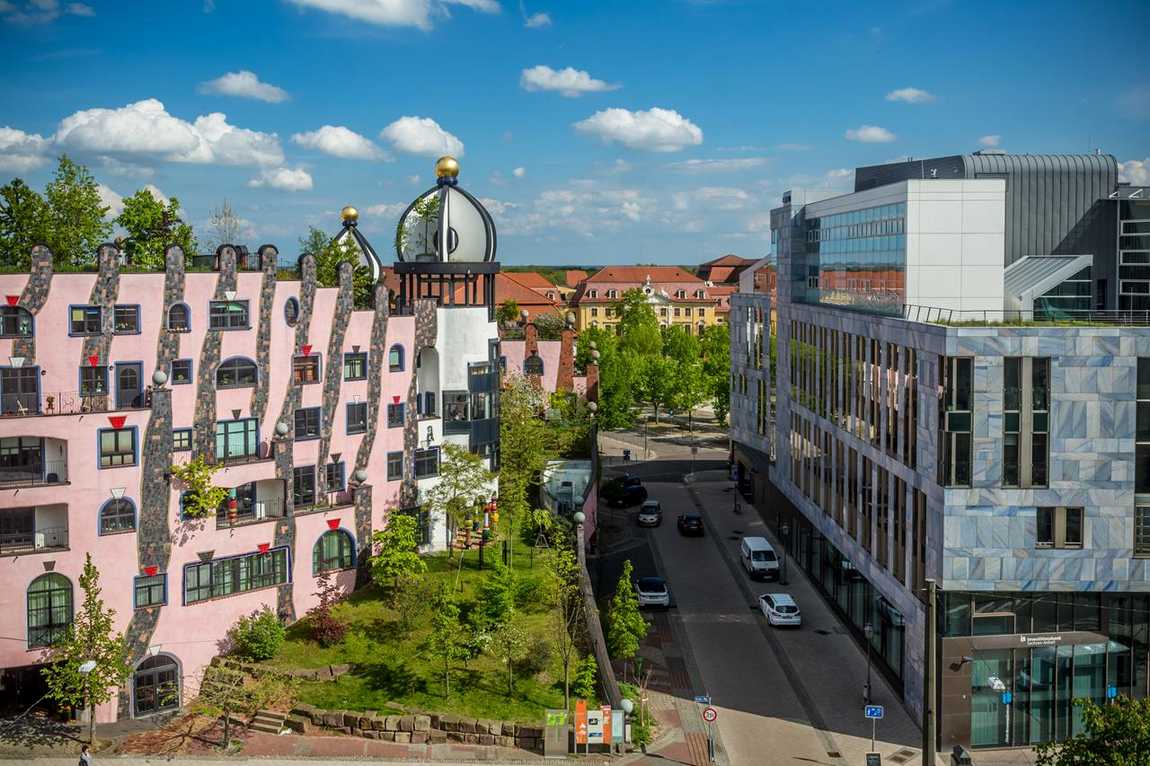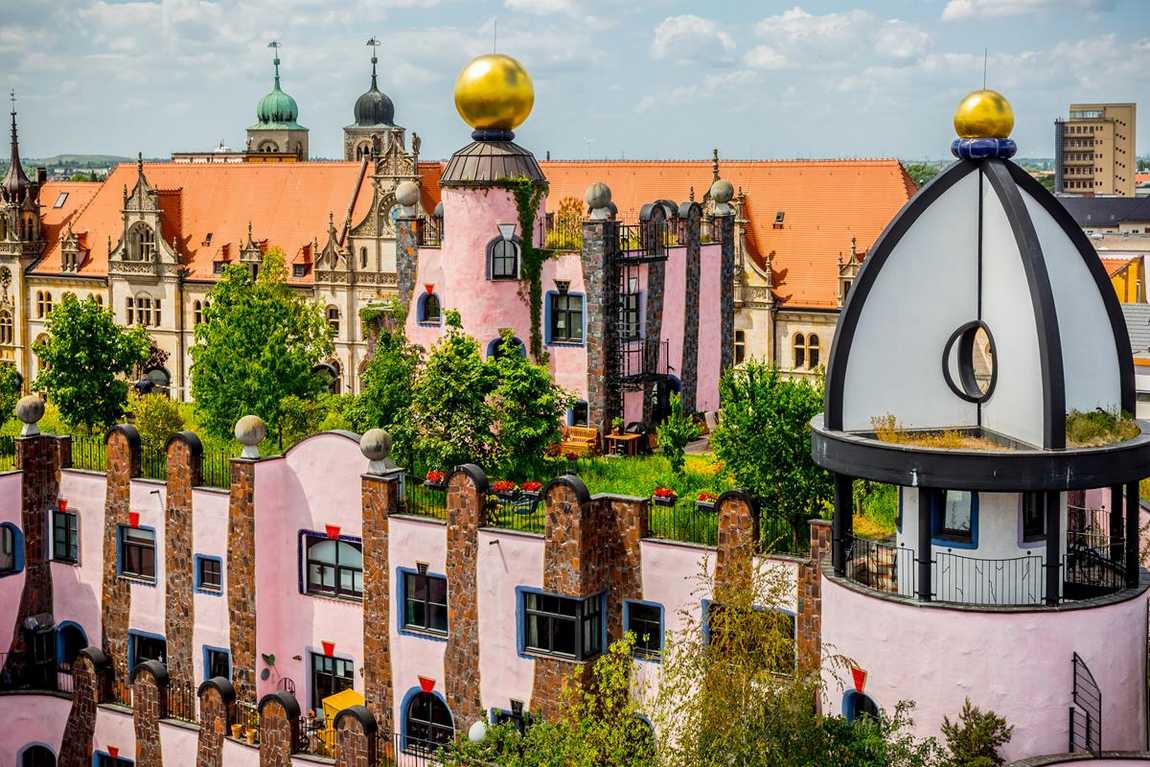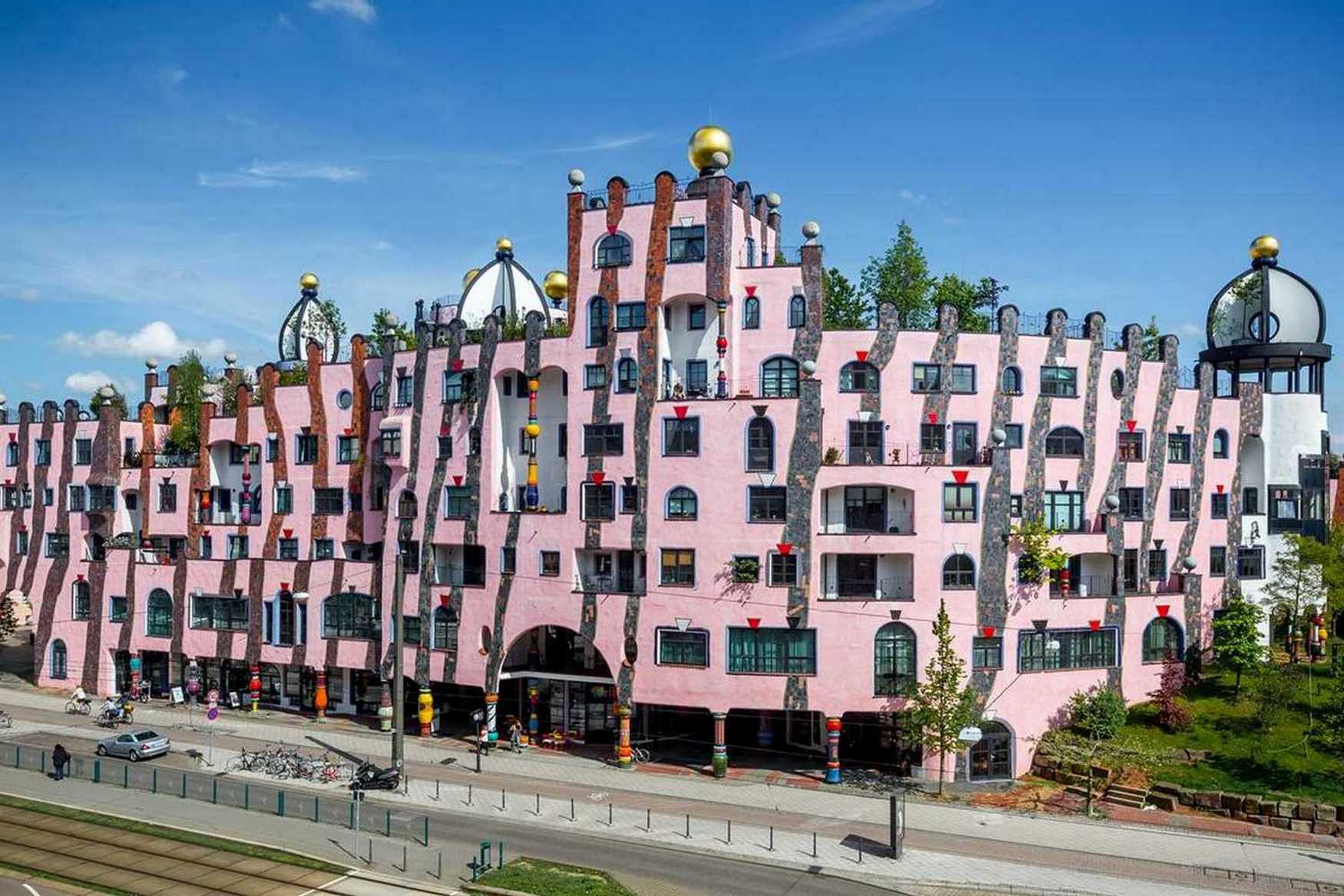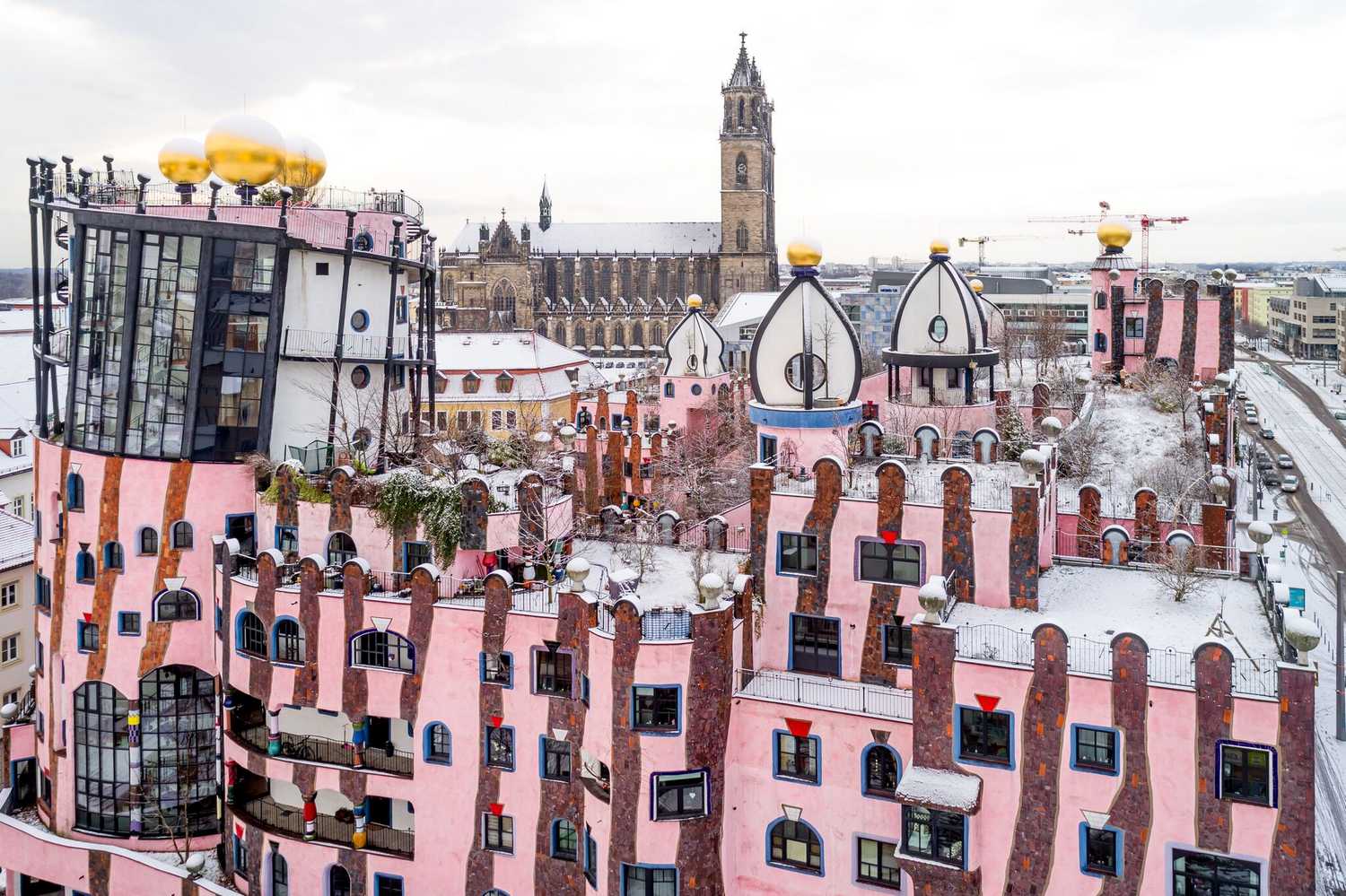In the heart of Magdeburg, Germany, stands a vibrant testament to architectural innovation and ecological harmony - Hundertwasser's Green Citadel. This extraordinary building, completed in 2005, was the last project of the visionary Austrian artist Friedensreich Hundertwasser. Located on Breiter Weg, near Cathedral Square and the Elbe River, the Green Citadel contrasts the city's Gothic cathedral and Romanesque monastery. This mixed-use complex embodies Hundertwasser's philosophy of living harmoniously with nature with its undulating floors, dancing windows, and golden domes. The Green Citadel isn't just a building; it's a living, breathing art that challenges conventional architecture and invites visitors to experience a world where creativity and sustainability coexist.
Highlights
- Colorful facade with organic shapes and ceramic tiles
- Rooftop gardens and "tree tenants" integrated into the building
- Mixed-use spaces, including apartments, shops, and a kindergarten
Contents
 Photo: https://www.gruene-zitadelle.de/
Photo: https://www.gruene-zitadelle.de/
Here is Why Your Kids Will Find it Interesting
Hundertwasser's Green Citadel is worth visiting with kids aged 5-12 with a penchant for whimsy and wonder. The building's playful design, reminiscent of a fairy tale castle, sparks imagination and curiosity. Children will be captivated by the colorful facades, quirky windows, and the idea of trees growing from balconies. The on-site kindergarten and rooftop gardens offer a glimpse into a world where nature and architecture blend seamlessly. Young visitors can enjoy a game of "spot the difference" between the Green Citadel and surrounding buildings, making it an educational and entertaining experience.
Family-friendly features
- Interactive guided tours tailored for children
- On-site kindergarten with playful architectural elements
- Rooftop garden exploration and nature-spotting activities
The Vision Behind the Green Citadel
Friedensreich Hundertwasser's architectural philosophy was rooted in the belief that humans should live in harmony with nature. The Green Citadel embodies his concept of an "oasis for humanity and nature" in an urban setting. Hundertwasser advocated for:
- Organic architecture that mimics natural forms
- Integration of vegetation into buildings
- Individualized living spaces
- Rejection of straight lines and uniformity
His "third skin" concept viewed architecture as an extension of human identity, emphasizing the importance of creative expression in living spaces.
.jpg) Photo: https://www.gruene-zitadelle.de/
Photo: https://www.gruene-zitadelle.de/
Architectural Features
The Green Citadel of Magdeburg is a testament to Hundertwasser's unique architectural vision, showcasing many design elements that set it apart from conventional buildings. The exterior is a symphony of curved lines and organic shapes, with undulating walls and irregular forms that reflect the artist's famous aversion to straight lines. This unconventional approach extends to the facade, adorned with vibrant hues and handcrafted ceramic tiles, creating a mosaic-like appearance that catches the eye and sparks the imagination.
One of the most striking features of the Green Citadel is its "dancing windows." Each window is uniquely shaped and positioned, giving the impression of movement and life to the building's exterior. This playful design continues inside, where visitors and residents alike experience the gentle slopes and uneven surfaces of the undulating floors. Hundertwasser poetically described these as "melodies for the feet," turning walking into an adventure.
Stadtpark Rotehorn is 1.9 km away and is well worth a family stroll.
True to its name, the Green Citadel integrates nature into its very structure. Rooftop gardens and "tree tenants" are not mere decorations but integral parts of the building's design. Trees grow from balconies and rooftops, blurring the line between architecture and nature. This commitment to greenery extends the concept of an urban oasis, creating a living, breathing structure that changes with the seasons.
Perhaps one of the most innovative aspects of the Green Citadel is the concept of "window rights." Residents are encouraged to decorate the area around their windows, fostering individual expression and ensuring that no two parts of the building look identical. This feature embodies Hundertwasser's belief in the importance of human creativity in living spaces, turning the entire building into a constantly evolving work of art.
These architectural features combine to create a building that is more than just a structure – it's a living entity that challenges our perceptions of what architecture can be. The Green Citadel is a colorful rebellion against the modern urban landscape's uniformity, inviting residents and visitors to experience a space where creativity, nature, and human habitation coexist in harmonious chaos.
 Photo: https://www.gruene-zitadelle.de/
Photo: https://www.gruene-zitadelle.de/
Inside the Green Citadel
The Green Citadel is a mixed-use complex offering diverse spaces:
| Space Type | Description |
| Residential apartments | 55 individualized units |
| Shops and cafes | Ground floor retail spaces |
| Hotel Art | Hotel for overnight stays |
| Offices | Professional spaces |
| Kindergarten | FriedensReich Daycare Centre |
| Medical practices | Healthcare facilities |
| Theater | Theater Grüne Zitadelle |
The building also features inner courtyards with a fountain, creating tranquil spaces within the urban environment.
Construction and History
The Green Citadel's journey from concept to reality:
- 1999: Hundertwasser presents his vision for the site
- 2004: Ground-breaking ceremony
- 2005: Completion and inauguration
Hundertwasser collaborated with architects Peter Pelikan and Heinz M. Springmann to bring his design to life. The project replaced a GDR-era prefabricated slab building, transforming the area into an architectural antithesis of the previous structure.
Exploring the Green Citadel
Visitors can experience the Green Citadel through:
- Guided tours offering insights into Hundertwasser's philosophy and the building's features
- Self-guided walks around the exterior and public areas
- Stay at the hotel for an immersive experience
Notable areas to visit include:
- The uniquely designed visitors' toilet
- The Theater Grüne Zitadelle for cultural events
- The rooftop gardens for panoramic views of Magdeburg
Tips for visitors:
When planning a visit to the Green Citadel, remember a few tips for an optimal experience. First and foremost, it's wise to don comfortable shoes, as the building's signature undulating floors can be quite the adventure for your feet. While charming, the gentle slopes and uneven surfaces might prove challenging in less practical footwear. Next, don't forget to bring a camera or ensure your phone has plenty of storage space.
The Green Citadel is a photographer's dream, with its vibrant details, unique architectural elements, and ever-changing play of light and shadow begging to be captured. Lastly, it's worth setting aside extra time to explore the surrounding area. The nearby Magdeburg Cathedral, a stunning example of Gothic architecture, contrasts Hundertwasser's modern masterpiece.
By following these suggestions, visitors can fully immerse themselves in the artistic and historical richness of this remarkable corner of Magdeburg.
Best Time to Visit
It is a year-round destination, but spring and summer offer the best opportunity to enjoy the rooftop gardens in full bloom. Weekday mornings are ideal for families, as the complex is less crowded. Weekends can be busier but offer a lively atmosphere with open shops and cafes.
Recommended Duration: A comprehensive visit, including a guided tour and exploration time, typically takes 2-3 hours.
Our Recap
Hundertwasser's Green Citadel is a bold statement against architectural conformity, offering visitors a chance to experience a building that embraces nature and individuality. Its playful design, eco-friendly features, and diverse spaces make it an engaging family destination. While it may challenge traditional notions of architecture, the Green Citadel provides a unique opportunity to explore the intersection of art, nature, and urban living.











